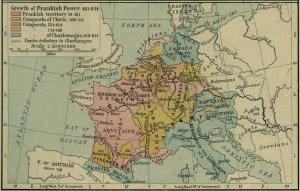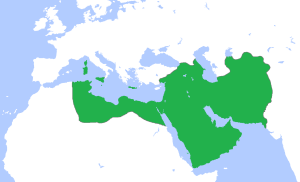At the time of the Abbasid Caliph in Baghdad, Haroun Al-Rasheed, in 772 A.D. the king of france, Charlemagne son of Pepin the short (i.e., Pepin III), Led his army of the Franks to hold a seige in order to submit Rome of Italy to his rule. The siege lasted until the spring of 774 A.D., when Charlemagne visited the pope in Rome. There he confirmed his father’s grants of land, with some later chronicles claiming—falsely—that he also expanded them, granting Tuscany, Emilia, Venice, and Corsica then he conquered Benevento in 787 A.D. to have all of Italy under his power. In 779 A.D. he led the army to conquer Lombardy and then he he conquered Saxonia and proceeded to convert the conquered to Roman Catholicism, using force where necessary. In 794 A.D., he was made to renounce any claim to Bavaria for himself and his family (the Agilolfings) at the synod of Frankfurt.
Charlemagne in 793 A.D. had the desire of being more of a protector of Christian pilgrims going to the Holy Land than Byzantine. He had a deal with Haroun The Caliph to provide this protection, while the Franks would fight the Umayyads in Al-Andalus (in the Iberian Peninsula) until they are being demolished. Four years later in 797 A.D., the Caliph Haroun of Baghdad, the city of modern civilization at that time, sent gifts with the delegates of Charlemagne headed by a Jewish minister called Isaac. The gifts included rare Indian fabric, an Asian elephant called “Abul-Abbas”, and a clock. When the gift arrived, people of Charlemagne thought the clock was a sort of Eastern magic and they decided to break it down, yet Charlemagne heard about their decision and stopped them. Haroun in 798 A.D. sent to Charlemagne an offer of scholarships for the Franks to send their young students to study medicine, geometry, Algebra, and Astronomy in the schools of Baghdad and Khawarizm.
In 797 Barcelona, the greatest city of the region, fell to the Franks when Zeid, its governor, rebelled against Cordoba and, failing, handed it to them. The Umayyad authority recaptured it in 799. However, Louis of Aquitaine marched the entire army of his kingdom over the Pyrenees and besieged it for two years, wintering there from 800 to 801, when it capitulated. The Franks continued to press forwards against the emir. They took Tarragona in 809 and Tortosa in 811. The last conquest brought them to the mouth of the Ebro and gave them raiding access to Valencia, prompting the Emir al-Hakam Ito recognise their conquests in 812.



